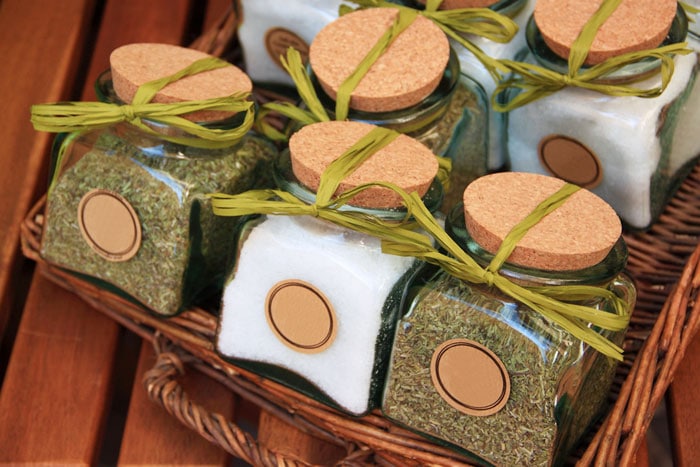
Written By: Christina Newberry
Reviewed By: Gloria Tsang, RD
Title: Registered Dietitian
Last Updated on:

As summer reaches its peak, home gardens go into overdrive. If your garden produces more than you can use, there are many ways of preserving your harvest for later in the year. But your garden’s bounty can also be transformed into lovely edible gifts to share with friends and family. Homemade gifts may take a little more time and effort than just picking something up at the store – but they are an excellent way of showing your loved ones that you really care, and can save you quite a lot of money, too. Here are some easy ideas for great gifts you can make this summer. (And I mean really easy – no preserving skills required!) Give them as birthday gifts or hostess gifts, or even put them away for a few months and bring them out in December. You’ll have a head start on your holiday shopping (and have trimmed your holiday shopping budget).

Table of Contents
This is probably the easiest of all the garden gifts. Simply take cuttings of low-moisture herbs like rosemary, sage, thyme, and oregano, and hang them to dry in a clean, dry place. Once they are fully dried, you can put them into a small glass jar and attach a hand-printed label. For a more rustic look that also preserves the herbs’ flavor best, try to keep the leaves whole.
If you’ve grown hot peppers, you probably have overflow – unless your family really likes spicy food! If you have friends or family who like to give their food a little kick, this is a great, easy, and attractive gift. Just gather your peppers (you can mix in some bell peppers too to lessen the spice), wash, and pat dry. You can dry the peppers either by threading them together and hanging them in a warm, dry area of your home or in the hot sun outside for several days or by cooking them on baking sheets in a 200 degree oven for about six hours. Once your peppers are dry, make sure they’re cool, and then put them in the food processor and process until you get the desired consistency. Put them in a glass jar, affix a label, and you’re done!
Layering herbs in salt is a traditional method of preservation. With a few modifications, you can use this technique to create salts and sugars that capture the flavors of the fresh herbs and make an excellent addition to savory recipes (salts) or baking (sugars). The technique is the same whether you use salt or sugar: Gently press the leaves of fresh herbs with the back of a spoon to release their oils, and put a few springs’ worth at the bottom of a jar. Top up the jar with salt or sugar and stir to mix in the herbs. Seal the jar and put it in a cool, dry place for two to three weeks, opening it up every two or three days to give it a good stir. By the final stir, the herbs should be fairly dry and broken up into flakes, and the salt or sugar will be infused with the herbal oils. Don’t sift out the bits of herbs – they give the salt or sugar a lovely appearance – just make sure they are small enough to be subtle when used. For sugars, try using lavender or mint, and for salt try rosemary or sage.
Beans and peas are the easiest vegetables to dry. You literally just ignore them! Simply leave the pea or bean pod on your plant until it’s brown and dry, then open it up. Check to make sure the beans or peas inside are hard and fully dry. If they’re a bit soft, put them in a dry place with good air circulation to continue drying. Once they are fully dry, put them in a jar. You can use just one kind of beans or peas, or mix some together for visual appeal. A jar of homegrown, home-dried beans is a perfect gift to give in the middle of winter, as they make a great addition to hearty soups and chilies. If you have a favorite soup recipe using dried beans, you could print it on a recipe card and tie it to the jar with a ribbon.
A bonus: If you have gardener friends, you could put just a few dried peas or beans in a paper packet or small envelope labeled with the plant’s name (and maybe even a picture) for them to plant instead of eat.
Creating gifts from your garden doesn’t have to be a lot of work, and you don’t need any specialized equipment or knowledge. Take a few hours one weekend to prepare these gifts, and you’ll be well stocked for gift-giving occasions for months to come.
Alumni: University of Victoria – Christina Newberry is a writer and editor whose work has appeared in national and local magazines and newspapers. With a Bachelor’s degree in English and Anthropology from the University of Victoria and a Journalism Certificate from Langara College, Christina brings keen curiosity and the love of a good story to her work with HealthCastle.com.
Christina is a passionate traveler and urban gardener with an interest in vegetarian eating and making good, tasty food from scratch. Sharing lessons learned from her own experiences, Christina writes about lifestyle topics for HealthCastle, with a focus on eating well at home and on the road.
beans, herbs, peas, preserves, vegetable gardening